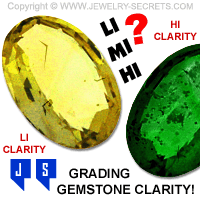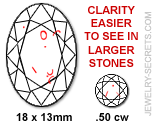HOW DO YOU DETERMINE GOOD GEMSTONE CLARITY?
WHAT IS THE BEST CLARITY TO BUY WHEN YOU'RE DEALING WITH GEMSTONES?
This post contains affiliate links. If you use these links to buy something I may earn a commission. Thanks! As an Amazon Associate I also earn from qualifying purchases.

A lot of people understand the basics of diamond grading and the 4C’s. But what about gemstones? Where do they fit in?
Is there a similar grading system that helps customers understand clarity in gemstones?
Is there a 4C’s for gems?
The answer: NO! (And that’s a big fat NO!)
Hard to believe but it’s true. So how is one supposed to judge the quality and clarity of a gem?
Well…
It’s not as easy as you’d think.
Gemstone clarity and gemstone color are all interlinked.
You see, gems can have just as many flaws and imperfections in them as diamonds can (in many cases more). They can have pits, cracks, black spots, feathers, clouds and chips. But the reason clarity gets so tough to judge is that a lot of these foreign materials found in gemstones are also the same thing that give the stone its color.
Inclusions give color:
The introduction of minerals, materials and elements help give gemstones their wonderful hue. Things like iron, nickel, chromium and aluminum. Take emerald for example, (see image above), emerald is best known for its deep, dark, rich, green hues (most people buy a gem based solely upon its color). But that color is actually influenced by the arrival of chrome. Without chrome, emerald would be transparent, clear and boring.
Most gemstones need other minerals (which usually show up as inclusions) to give it color. So to view some gems without inclusions, would be viewing them with no color. Scary eh?
LI, MI, HI clarity:
But, all hope is not lost. There is a little grading system going on for gems that jewelers do use. (nothing written in stone though). The 3 main clarity grades used are:
- LI- Lightly Included
- MI – Moderate Included (Medium)
- HI – Highly Included
These categories are rough and pretty much just the jeweler’s opinion (which can also lead to inconsistencies). But at least it’s something.
Judging clarity:
To judge clarity for yourself, look at the gemstone with a microscope or a 10x jeweler’s loupe. You’ll be able to determine if a stone has a lot of inclusions or not.
The cleaner the stone the better.
(As long as the gemstone still has great color.)
In the picture above, I show 2 gemstones. A yellow topaz that is LI clarity, and an emerald that is HI clarity (MI clarity falls in between the two).
Emeralds are commonly found with HI clarity, so don’t be alarmed, that’s just how emeralds are. Most other gemstones and birthstones will be found more in the LI clarity or MI clarity range.
 The funny thing about inclusions in gemstones, is that they are more apparent to the bare eye than inclusions in diamonds are.
The funny thing about inclusions in gemstones, is that they are more apparent to the bare eye than inclusions in diamonds are.
The main reasons for this is that gemstones are usually more transparent (see through), they don’t have much brilliance or sparkle to hide their flaws. And gemstones are generally bigger in carat size than diamonds are, which makes the inclusions much easier to spot.
Just compare the image to the left of a 18 x 13mm gemstone up against a .50 carat diamond – see what I mean?
All in all, inclusions are not a bad thing in gemstones. They help with the color and help to identify the stone as well (all good things).
Check for cracks though:
Most of the gemstones you find in jewelers today will be either classified as LI clarity or MI clarity. But before you buy them, make sure you check the gem for any cracks or fissures running long-wise through the stone. Faults like this could make the stone brittle and break easily (opals are known for this weakness). Also be sure to check the girdle for chips or nicks around the outer edge because that could also cause it to crack or bust if hit.
Too good to be true:
If you find a gem that appears too clean and too perfect, chances are it may not be real. Perfectly clean stones are a sign that the gem could be fake, synthetic or man-made. Always make sure you ask the salesperson if the stone that you’re looking at is natural and genuine or created in a laboratory (big difference in price).
So there you go. That’s gem clarity.
If you’re out shopping for gemstones, remember:
Simple rules
- LI – MI clarity
- No long cracks or fissures
- No chips or nicks in the girdle
These three easy steps will help you find the right gemstone to buy.
Now if you’ll also make sure to get a stone that’s dark in color as well… Then you’ll really be doing yourself justice.
Happy shopping!
And if you want to view some beautiful loose and magnified gemstones, head on over to James Allen here.
Cheers! :)














Leave a comment